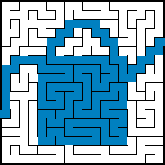Picture maze


A picture maze is a maze puzzle that forms a picture when solved.
Rules
Picture mazes require no special rules or learning. The rules are very simple:
- Draw a path from the entrance to exit of the puzzle, avoiding the dead ends.
- Fill the squares along the path to reveal the hidden picture.
It is interesting to note that because of two rules, it is far simpler to reverse the process to solve this puzzle. Starting at a dead end, the path is filled until it reaches an intersection with three or more paths connecting to it. This process is repeated until all dead-end paths are filled, often showing the shortest path. On larger pieces, this is the only way to solve, as there are too many possible but incorrect paths, and chance of finding the correct path based on intuition, logic or simple luck is almost nonexistent.
History
Picture Mazes were first pioneered by Francesco Segala, a 15th-century architect from Padua, Italy. He created puzzle maze designs, mainly in figurative forms. His designs included ships, dolphins, crabs, dogs, snails, horsemen and human figures. It is doubtful whether any of his designs were actually constructed in hedges. (Further information and illustration in the book "Secrets of the Maze" by Adrian Fisher, page 35).
In 1975, the English maze designer Randoll Coate began his life's work of creating numerous "symbolic" mazes, which combined a distinctive outer image with further internal symbols and images. His earliest works, built as hedge mazes in the landscape, included "Imprint" (a gigantic footprint) in a private garden in Oxfordhsire, England in 1975; "Creation" (egg-shaped, containing a Minotaur, and - alternatively but superimposed - the Garden of Eden story) at Varmlands Saby, Varmlands, Sweden, in 1977; and "Pyramid" at the Château de Belœil, Belgium, in 1979. Randoll Coate went on to create many dozens of further Symbolic Mazes, 15 in conjunction with fellow Englishman Adrian Fisher.
Pictures mazes were also created in Japan sometime before 1986. Since then manually created picture mazes became popular in Japanese puzzle magazines published by Gakken, Nikoli Nikoli, Sun and other Japanese publishers.
The world's first cornfield maize maze was a Picture Maze, portraying a Stegosaurus (it being the year that the film Jurassic Park was premiered). This maze was created in 1993 at Lebanon Valley College, Annville, Pennsylvania, USA. It was the first of six cornfield maize mazes, each designed by Adrian Fisher, that have set Guinness World Records for progressively larger maize mazes, each one being a Picture Maze.
Computer algorithm picture mazes
Using computer algorithms, picture mazes can be created at different difficulty levels by controlling the length and density of the false paths. There are picture mazes in various sizes, from small mazes of 25×25 and up to colossal poster mazes of 200×200.